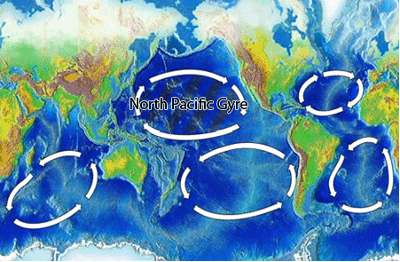The Great Pacific Garbage Patch or “Pacific Trash Vortex,” is a vast collection of plastic marine debris or litter stretching from the West Coast of the United States to Japan. A vortex of rotating ocean currents called the North Pacific Gyre traps the debris here. The Gyre forms where the North Pacific Current, California Current, North Equatorial Current, and the Kuroshio Current meet. Most of the debris originates on land as litter in coastal areas. Eventually, this litter ends up in the sea. Ocean currents then deliver it to North Pacific. About 20% of the trash comes from boaters, offshore oil rigs, and large cargo ships. Much of the debris that originates on the sea consists of fishing nets. The “whirlpool effect” created by the converging currents draws the debris into the calm center of the gyre and traps it there.
Some scientists believe that the Great Pacific Garbage Patch is twice the size of Texas, or nearly five million square miles. It currently contains approximately 11 million tons of trash. The patch continues to grow because, while plastics can break up into smaller pieces, they do not degrade or decompose.
Plastics of all sizes are a threat to the marine animals that live within the gyre. Turtles and seabirds mistake the trash for food; seals and other animals become entangled in fishing nets and drown. Floating trash can also prevent sunlight from reaching plankton and algae, which require sunlight to generate nutrients. These species form the basis of the oceanic food web. If they are unable to generate the nutrients they need, the many other species they support may be affected.
 The patch is continually mixed and reshaped by wind and waves. Much of the debris consists of very small pieces from broken-down plastic bottles, bags, wrappers, and styrofoam cups, and much of it floats below the surface. The patch can be difficult to spot with satellites and even the naked eye for these reasons.
The patch is continually mixed and reshaped by wind and waves. Much of the debris consists of very small pieces from broken-down plastic bottles, bags, wrappers, and styrofoam cups, and much of it floats below the surface. The patch can be difficult to spot with satellites and even the naked eye for these reasons.
Racing boat captain Charles Moore discovered the Great Pacific Garbage Patch while returning from a race in 1997. His discovery confirmed scientists’ predictions of its existence. It is only one of five major gyres around the globe.